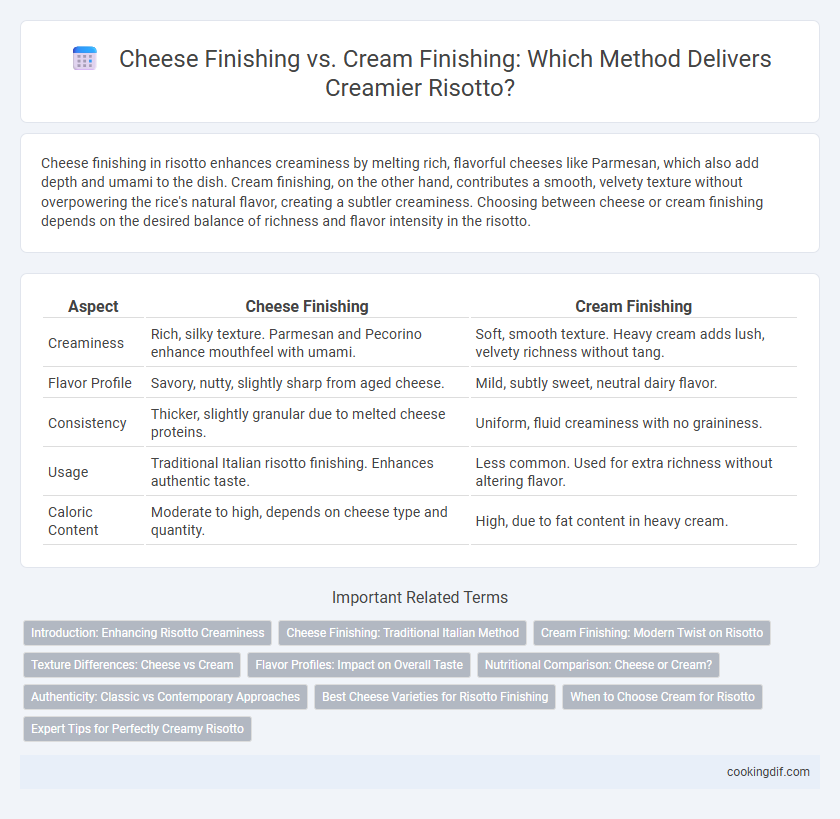Cheese finishing in risotto enhances creaminess by melting rich, flavorful cheeses like Parmesan, which also add depth and umami to the dish. Cream finishing, on the other hand, contributes a smooth, velvety texture without overpowering the rice's natural flavor, creating a subtler creaminess. Choosing between cheese or cream finishing depends on the desired balance of richness and flavor intensity in the risotto.
Table of Comparison
| Aspect | Cheese Finishing | Cream Finishing |
|---|---|---|
| Creaminess | Rich, silky texture. Parmesan and Pecorino enhance mouthfeel with umami. | Soft, smooth texture. Heavy cream adds lush, velvety richness without tang. |
| Flavor Profile | Savory, nutty, slightly sharp from aged cheese. | Mild, subtly sweet, neutral dairy flavor. |
| Consistency | Thicker, slightly granular due to melted cheese proteins. | Uniform, fluid creaminess with no graininess. |
| Usage | Traditional Italian risotto finishing. Enhances authentic taste. | Less common. Used for extra richness without altering flavor. |
| Caloric Content | Moderate to high, depends on cheese type and quantity. | High, due to fat content in heavy cream. |
Introduction: Enhancing Risotto Creaminess
Cheese finishing in risotto, typically with Parmigiano-Reggiano, intensifies the dish's umami and adds a rich, savory depth, while cream finishing provides a silky texture that enhances smoothness without overpowering flavors. Using high-quality aged cheeses not only boosts creaminess but also contributes essential fat and protein that bind the rice grains. Cream finishing is less traditional but can soften the dish's acidity and create a luscious mouthfeel, making it ideal for delicate or vegetable-based risottos.
Cheese Finishing: Traditional Italian Method
Cheese finishing in risotto, a traditional Italian method, enhances creaminess by incorporating grated Parmesan or Pecorino at the end of cooking, allowing the cheese to melt smoothly into the rice. This technique preserves the dish's authentic texture and deepens its savory flavor profile, creating a rich, velvety consistency without overpowering the delicate rice grains. Compared to cream finishing, cheese finishing delivers a balanced creaminess infused with umami, maintaining the risotto's classic Italian essence.
Cream Finishing: Modern Twist on Risotto
Cream finishing in risotto offers a modern twist by enhancing creaminess with a smooth, velvety texture that cheese alone cannot achieve. This method allows for a consistent, luscious mouthfeel, maintaining the dish's delicate balance without overwhelming its subtle flavors. Using cream as a finishing touch also adapts risotto to contemporary dietary preferences and creative variations.
Texture Differences: Cheese vs Cream
Cheese finishing in risotto contributes a rich, slightly grainy texture that enhances the dish with depth and a savory umami flavor through melting varieties like Parmesan or Pecorino. Cream finishing creates a smoother, silkier consistency, enveloping the rice grains with a uniform creaminess that softens the overall mouthfeel. The choice between cheese and cream finishing affects the risotto's texture, where cheese offers a more complex bite and cream delivers a luscious, velvety finish.
Flavor Profiles: Impact on Overall Taste
Cheese finishing in risotto enhances the dish with rich umami and tangy notes, adding depth and complexity to the overall flavor profile. Cream finishing provides a smooth, mellow texture that softens sharp ingredients without overpowering delicate flavors. Combining cheese and cream can balance bold and subtle tastes, creating a harmonious and creamy risotto experience.
Nutritional Comparison: Cheese or Cream?
Cheese finishing in risotto adds protein, calcium, and vitamin A, while contributing moderate fat content depending on the cheese type, enhancing both creaminess and nutritional density. Cream finishing provides higher saturated fat and calories with fewer proteins and micronutrients compared to cheese, making it richer but less nutrient-dense. Choosing cheese over cream for risotto improves calcium intake and maintains a creamier texture with added nutritional benefits.
Authenticity: Classic vs Contemporary Approaches
Traditional risotto achieves its signature creaminess through the gradual incorporation of starchy, hot broth and the finishing addition of aged Parmigiano-Reggiano cheese, enhancing flavor while maintaining authenticity. Contemporary approaches often introduce cream or mascarpone to intensify richness but can compromise the dish's classic texture and balance. Authentic risotto prioritizes cheese finishing for a harmonious blend of creaminess and depth, reflecting time-honored Italian culinary techniques.
Best Cheese Varieties for Risotto Finishing
Parmigiano-Reggiano stands as the quintessential cheese for finishing risotto, delivering a rich, nutty depth that enhances the dish's creamy texture without overpowering its delicate flavors. Grana Padano and aged Pecorino Romano provide robust, savory notes ideal for risottos with bolder profiles, melting seamlessly into the dish for a luxurious mouthfeel. Opting for cheese finishing over cream maintains the authentic Italian tradition, adding complex umami layers while preserving the risotto's signature silkiness.
When to Choose Cream for Risotto
Choose cream for risotto when seeking an ultra-silky texture that cheese alone cannot provide, especially if the cheese used lacks high fat content. Cream enhances the dish's richness without overpowering delicate flavors, making it ideal for risottos featuring subtle ingredients like seafood or mild vegetables. This finishing technique ensures a smooth, luscious consistency while maintaining balance and depth in the overall flavor profile.
Expert Tips for Perfectly Creamy Risotto
Expert tips for perfectly creamy risotto emphasize finishing with cheese, such as Parmigiano-Reggiano, to enhance flavor and achieve a silky texture without overpowering richness. Cheese melting into the risotto binds the starches, creating a smooth, luscious consistency that cream alone cannot replicate. High-quality Parmesan combined with proper stirring and gradual broth addition ensures an authentic, velvety risotto each time.
Cheese finishing vs cream finishing for creaminess Infographic

 cookingdif.com
cookingdif.com